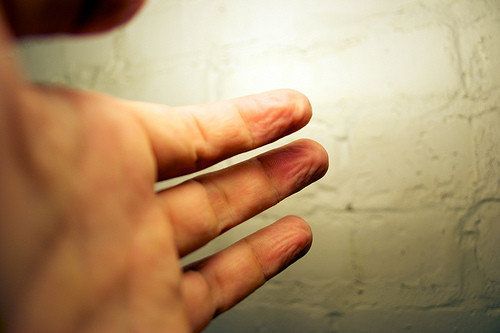
You get out of the bathtub (or shower or swimming pool) eager to grab your towel and dry off. But before you do so, you can’t help but touch your fingertips together and stare down at the odd-looking wrinkles that have formed on the surface. Yes, we all know well the feeling of developing “pruney” fingers. But have you ever thought about why our fingers suddenly morph into raisins? A team of scientists in Boise, Idaho believe that they’ve solved the mystery.
The answer, according to evolutionary biologist Mark Changizi, is all about “grip.” Changizi and his team of researchers at 2AI Labs, believe that water wrinkles are essentially treads -- just like the ones that show up on our car tires -- that have been genetically selected for over time.
Changizi’s research team closely analyzed 28 photographs of wrinkled fingers, methodically tracking similarities in their wrinkling patterns. The researchers found that the fingertips they examined all had wrinkles that formed vertical channels, stemming from the tip of the finger. Accordin to Changizi, these ridges work to prevent water from pooling on the flat part of our fingertips. His hypothesis is supported by the fact that when nerve endings in the feet or toes are severed, those digits do not wrinkle. This indicates that the nervous system is controlling the reaction.
The inspiration for the study, which was published last week in the journal Brain, Behavior and Evolution, came from one of Changizi’s students. "I stumbled upon these nearly century-old papers and they immediately suggested to me that pruney fingers are functional," Changizi told Nature News. "I discussed the mystery with my student Romann Weber, who said, 'Could they be rain treads?' 'Brilliant!' was my reply."
Changizi believes that his hypothesis warrants further research. He plans to look into whether mammals that reside in wet climates are more likely to get pruney fingers than those living in dry habitats. He has already located photographic evidence of a Japanese monkey with wrinkled fingers and told Nature News that “pilot experiments,” testing whether wrinkled fingers actually allow for better grip, have already begun. Thus far, the evidence seems to be giving Changizi’s theory two (wrinkly) thumbs up.
Although many are applauding Changizi’s new hypothesis, not everyone is sold. Columbia University biomechanical engineer, Xi Chen is one of these naysayers. He contends that when fingers and toes are immersed in hot water, the tissue below the skin’s surface contracts, forcing the skin to buckle. “It’s a classic mechanics problem,” he told Nature News. However, this theory does not account for wrinkling that happens in cold water.